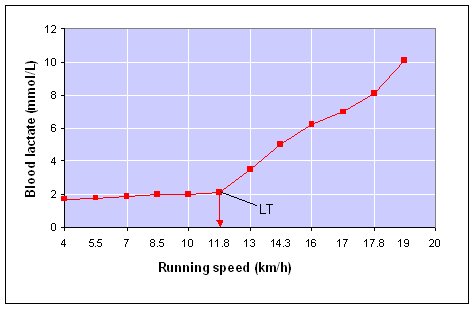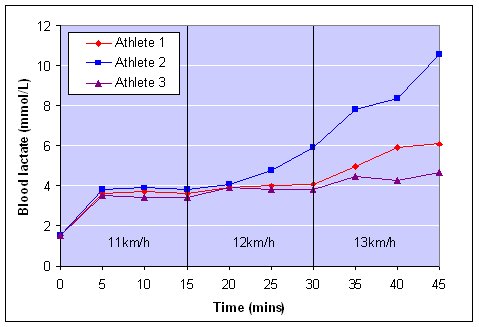There are several methods used to determine an athletes lactate or anaerobic threshold. While the most accurate and reliable is through the direct testing of blood samples during a graded exercise test, this is often inaccessible to most performers.
There are several field tests that can also be used to estimate lactate threshold. They vary in their reliability but some offer an acceptable alternative for most amateur athletes.
Several terms such as onset of blood lactate accumulation and maximal lactate steady state are used interchangeably with anaerobic threshold. Technically, they do not describe precisely the same thing. In fact, although lactate threshold and anaerobic threshold occur together under most conditions, strictly speaking even these two terms are not the same (1). For this article however, lactate threshold and anaerobic threshold will be used interchangeably. See the lactate threshold article for more details on this topic.
It is also worth bearing in mind that blood lactate and lactic acid are not the same substance. Blood lactate production is actually thought to be beneficial to endurance performance and may delay fatigue. Nevertheless, its accumulation still remains a good marker for the onset of fatigue. See the lactic acid article for more information.
Laboratory Testing of Anaerobic Threshold
The most accurate way to determine lactate threshold is via a graded exercise test in a laboratory setting (2). During the test the velocity or resistance on a treadmill, cycle ergometer or rowing ergometer is increased at regular intervals (i.e. every 1min, 3min or 4min) and blood samples are taken at each increment. Very often VO2 max, maximum heart rate and other physiological kinetics are measured during the same test (3).
Blood lactate is then plotted against each workload interval to give a lactate performance curve. Heart rate is also usually recorded at each interval often with a more accurate electrocardiogram as opposed to a standard heart rate monitor.

Once the lactate curve has been plotted, the anaerobic threshold can be determined. A sudden or sharp rise in the curve above base level is said to indicate the anaerobic threshold. However, from a practical perspective this sudden rise or inflection is often difficult to pinpoint.
Assuming the inflection is clear (as in the graph above), the relative speed or workload at which it occurs can be determined. In this example, the athletes anaerobic threshold occurs at about 12km/h. This means, in theory they can maintain a pace at or just below 2km/h for a prolonged period, indefinitely. Of course, this is purely hypothetical as there are many other factors involved in fatigue not least the amount of carbohydrate stores an athlete has in reserve (1). A crossover to fat metabolism will significantly reduce the athletes race pace (2).
By recording heart rate data alongside workload and blood lactate levels, an athlete can use a heart rate monitor to plan and complete training sessions. Although monitoring heart rate is never completely reliable and varies greatly between and within individuals (1,2,3) combining it with lactate measurements is probably more reliable than using the Conconi test (see below) for example.
Confirmatory Test
When anaerobic threshold is read from the lactate curve, an additional test can be used to verify its accuracy. Using the example above, the athletes threshold is thought to occur at about 12km/h on the treadmill. The confirmatory test involves running for 15 minutes at a pace just below threshold, 15 minutes at threshold and 15 minutes at a pace just above threshold. See the curves below of three athletes whose thresholds have all been determined to occur at approximately 12kmh.

Notice that for Athlete 1, blood lactate remains steady at their estimated anaerobic threshold (12km/h) and lactate begins to accumulate when the pace is increased to 13km/h in the final 15 minutes. For athlete 1, this is confirmation that their anaerobic threshold pace is reasonably accurate.
For Athlete 2, lactate begins to accumulate during the middle 15minute segment (their estimated threshold) and continues to do so during the final 15 minutes. For this athlete, anaerobic threshold occurs at a slightly slower pace than was determined originally.
Finally, Athlete 3s lactate curve does not rise significantly even during the final 15 minutes segment. Anaerobic threshold for them occurs at a slightly higher pace then was originally determined.
Assuming, you dont have access to facilities that directly monitor your or your athletes lactate response, are there other acceptable alternatives?
Portable Lactate Analyzer
Portable lactate analysers are becoming more popular amongst coaches and athletes at all levels. A good portable analyzer should have the same validity and reliability as laboratory testing equipment. The Accutrend Lactate Analyzer for example, has been tested using guidelines of the European Committee for Clinical Laboratory Standards and is cleared for sports medicine use by the Federal Drug Administration in the United States.
Needless to say a portable analyser is only one half of the equation. A suitable and sport-specific exercise test is still required and selecting the most appropriate protocol takes knowledge and experience. Any physiological test is only as reliable as the testers ability to follow a set protocol. Even when a suitable assessment has been chosen, numerous variables must be kept constant for the test to remain accurate and reliable. See the fitness tests section for guidelines on keeping physiological assessments repeatable and sample tests that can be used for various sports.
Conconi Test
In 1982 Conconi et a (4) stated that the anaerobic threshold correlated to a deflection point in the heart rate. Essentially, heart rate and exercise intensity is linear i.e. as exercise intensity increases so will heart rate. However, Conconi et a found that in all their tested subjects, including those in a follow up test (5), heart rate reached a plateau at near maximal exercise intensities.
Although this is a relatively simple field test that would be useful for coaches and athletes at all levels, its accuracy has been contested by subsequent researchers (6,7,8). Studies have found that the deflection point or plateau in heart rate only occurs in a certain number of individuals and that when it does, it significantly overestimates directly measured lactate threshold. Conconi and co-workers (9) themselves acknowledge this controversy and cite studies that both support and contradict their original findings.
For guidelines on performing the Conconi test see the heart rate training page.
10km Run, 30Km Cycle, 30 Min Time Trial
More experienced athletes often run a 10km race or cycle 30km race at or close to anaerobic threshold. By simulating a race in training and recording heart rate, the anaerobic threshold may be determined. Alternatively, exercising for 30 minutes at the fastest sustainable pace can be used. The key is to sustain a steady pace which is why this test is more suited to experienced athletes who can gauge how fast to set off. A heart rate monitor with split time facility is required to record heart rate at each 1-minute interval. Take the average heart rate over the final 20 minutes as the heart rate corresponding to anaerobic threshold.
Heart Rate Percentage
A very simply method for estimating the anaerobic threshold is to assume anaerobic threshold occurs at 85-90% maximum heart rate (220-age). As mentioned earlier, heart rate varies greatly between individuals and even within the same individual so this is not a reliable test.
The Lactate Threshold Debate
Some researchers have questioned the validity of determining the lactate or anaerobic threshold even in laboratory settings (10,11). Yet more researchers question whether a definite point or threshold exists at all (10,12,13,14). Instead they suggest blood lactate accumulation is continuous in nature and no specific point can be determined.
Rather than get bogged down in the debate it is sensible to remember that regardless of the underlying mechanisms, the physiological changes that accompany lactate accumulation have important implications for endurance athletes. Any delay in the blood lactate accumulation that can be achieved through training is beneficial to performance. With that in mind, why not take a look through the lactate threshold training article?
References
1) Wilmore JH and Costill DL. (2005) Physiology of Sport and Exercise: 3rd Edition. Champaign, IL: Human Kinetics
2) McArdle WD, Katch FI and Katch VL. (2000) Essentials of Exercise Physiology: 2nd Edition Philadelphia, PA: Lippincott Williams & Wilkins
3) Maud PJ and Foster C (eds.). (1995) Physiological Assessment Of Human Fitness. Champaign, IL: Human Kinetics
4) Conconi, F., M. Ferrrari, P. G. Ziglio, P. Droghetti, and L. Codeca. Determination of the anaerobic threshold by a noninvasive field test in runners. J. Appl. Physiol. 1982, 52: 862-873
5) Ballarin, E., C. Borsetto, M. Cellini, M. Patracchini, P. Vitiello, P. G. Ziglio, and F. Conconi. Adaptation of the “Conconi test” to children and adolescents. Int. J. Sports Med. 1989, 10: 334-338
6) Parker, D., R. A. Robergs, R. Quintana, C. C. Frankel, and G. Dallam. Heart rate threshold is not a valid estimation of the lactate threshold. Med. Sci. Sports Exerc. 1997, 29: S235
7) Tokmakidis, S. P., and L. A. Leger. Comparison of mathematically determined blood lactate and heart rate “threshold” points and relationship to performance. Eur. J. Appl. Physiol. 64: 309-317
8) Vachon JA, Bassett Jr DR and Clarke S. Validity of the heart rate deflection point as a predictor of lactate threshold during running. J Appl Physiol. 1999, 87: 452-459
9) Conconi, F., G. Grazze, I. Casoni, C. Guglielmini, C. Borsetto, E. Ballarin, G. Mazzoni, M. Patracchini, and F. Manfredini. The Conconi test: methodology after 12 years of application. Int. J. Sports Med. 1996, 17: 509-519
10) Yeh MP, Gardner RM, Adams TD, Yanowitz FG, Crapo RO. “Anaerobic threshold”: problems of determination and validation. J Appl Physiol. 1983, Oct;55(4):1178-86
11) Gladden LB, Yates JW, Stremel RW, Stamford BA. Gas exchange and lactate anaerobic thresholds: inter- and intraevaluator agreement. J Appl Physiol. 1985 Jun;58(6):2082-9
12) Hughson RL, Weisiger KH, Swanson GD. Blood lactate concentration increases as a continuous function in progressive exercise. J Appl Physiol. 1987 May;62(5):1975-81
13) Campbell ME, Hughson RL, Green HJ. Continuous increase in blood lactate concentration during different ramp exercise protocols. J Appl Physiol. 1989 Mar;66(3):1104-7
14) Dennis SC, Noakes TD, Bosch AN. Ventilation and blood lactate increase exponentially during incremental exercise. J Sports Sci. 1993 Oct;11(5):371-5; discussion 377-8

Jacky has a degree in Sports Science and is a Certified Sports and Conditioning Coach. He has also worked with clients around the world as a personal trainer.
He has been fortunate enough to work with a wide range of people from very different ends of the fitness spectrum. Through promoting positive health changes with diet and exercise, he has helped patients recover from aging-related and other otherwise debilitating diseases.
He spends most of his time these days writing fitness-related content of some form or another. He still likes to work with people on a one-to-one basis – he just doesn’t get up at 5am to see clients anymore.